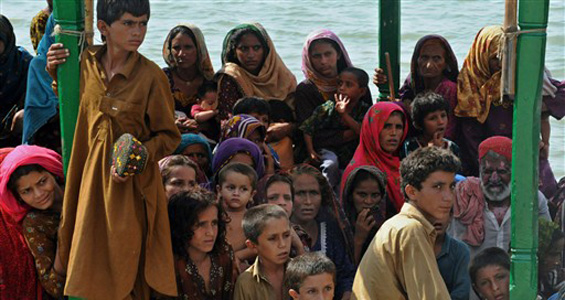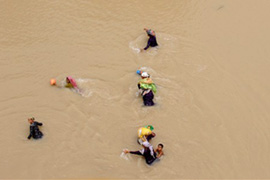Pakistan’s uneasy relationship
The region depends on monsoon rains, but too much rain has devastating consequences.

 |
| Fifteen million people have been affected by the floods, with four million made homeless [AFP] |
The southwest monsoon always brings rain to India, Nepal, Bangladesh and Pakistan. The monsoon rains are vital to life in the region, bringing as much as 80 per cent of the annual rainfall. The locals know when the rains are expected and, if they fail, this has disastrous consequences for crops and livelihoods.
But while the onset and withdrawal of the rains is predicted, the rains are not uniform. The monsoon is made up of smaller systems; low pressures and periods of heavier rains, and these always cause problems. Some places always receive way more rain than they can cope with. Flooding is inevitable.
Keep reading
list of 4 itemsAfter the Hurricane
World’s coral reefs face global bleaching crisis
Why is Germany maintaining economic ties with China?
Up until mid-July, this year’s rains had actually been quite subdued. Some parts of India were even concerned that they were not going to be sufficient.
But towards the end of July, meteorologists watched a low pressure move across India towards Pakistan. Heavy rain was expected and flooding was a real threat, but no one could have predicted the devastation that hit the country.
Knocked for six
 |
| Many roads and bridges have been washed away by the flood waters [AFP] |
After hammering Pakistan, this weather system then crossed the border into Afghanistan. If Pakistan was taken by surprise, then Afghanistan was completely knocked for six.
The high mountains to the south normally shield the country from the southwest monsoon altogether. This is usually the driest time and virtually no rain falls between June and October.
Of course this year was different. The flooding in Afghanistan shows the force of this storm, but the mountains did help a little. Most of the rain fell over Pakistan, so although Afghanistan was flooded, it was spared a much worse fate.
Pakistan shouldered the brunt of the storm. In the closing days of July, many parts of Pakistan saw more rain than they would expect in the whole month. Others, including Peshawar, saw more than they would expect in the entire year.
Clear-up operation
Statistics are all well and good, but essentially this means that the ground could not cope. It simply did not have a chance. There was no way that it could possibly absorb all the water that was falling from the skies.
The topography also worked against it. The mountainous terrain meant that all the water ran downhill, forming currents of torrid water, cutting down the hillside. Valleys were submerged as the waters poured down.
Eventually the water found the rivers and tributaries; all feeding into the mighty Indus River, and the misery has not ended yet. The swollen, high-level waters are now flowing south, towards the sea.
As the river waters roar southwards, the rains keep coming. Another area of low pressure is crossing southern Pakistan, bringing yet more heavy rain. Another 118mm to ground that is already saturated.
This system should clear by Tuesday, finally allowing the rains to ease a little. But they will not stop altogether – the wet season lasts until September, so heavy showers are likely throughout August.
As always with floods, the clear-up operation will be slow and difficult. It will take weeks to clear away the mud and debris, and months to rebuild the roads and bridges – much longer than a storm takes to wash them away.
The writer is Al Jazeera’s senior weather presenter.